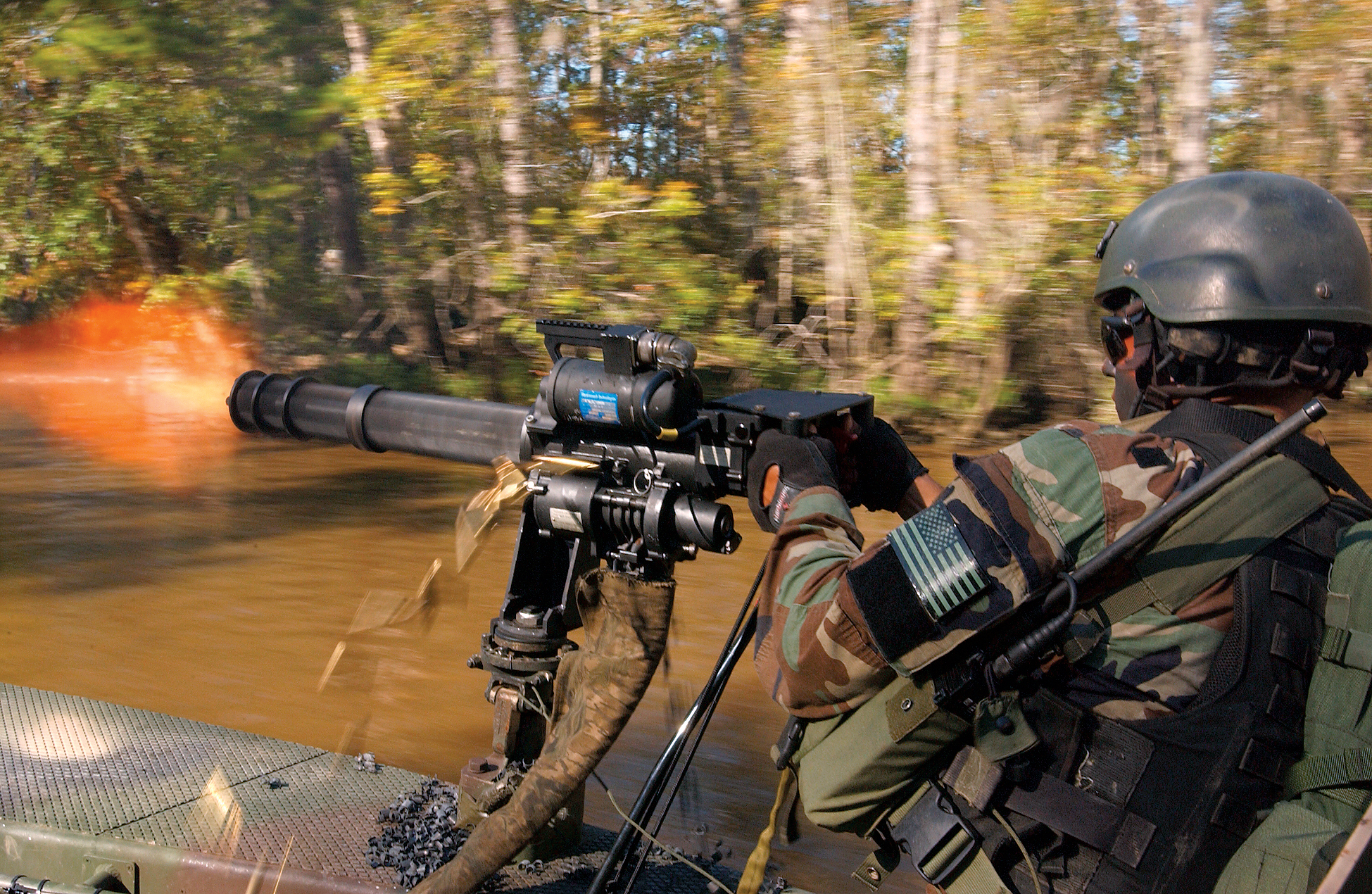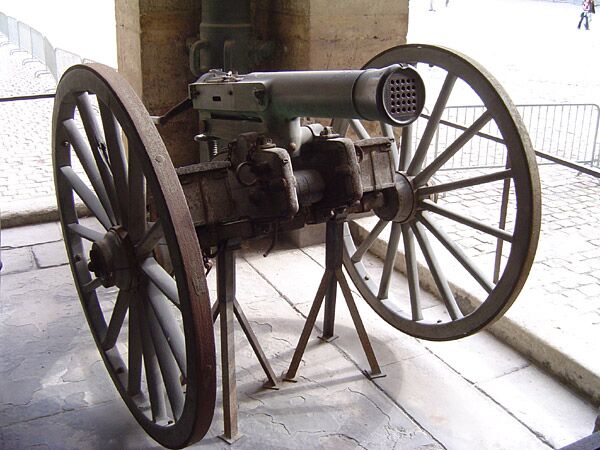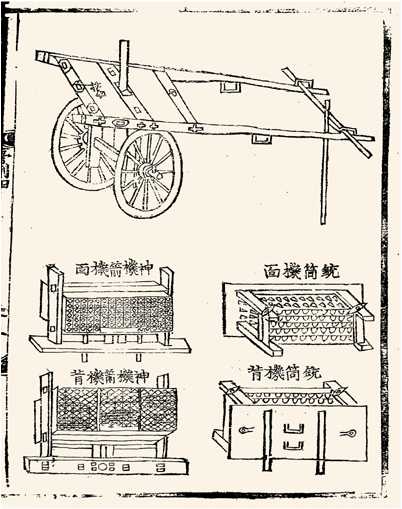|
Organ Gun
A ribauldequin, also known as a rabauld, ribault, ribaudkin, infernal machine or organ gun, was a medieval artillery, late medieval volley gun with many small-caliber iron barrels set up parallel on a platform, in use from the 14th through 17th centuries. When the gun was fired, multiple barrels discharged their projectiles at once, yielding a much higher rate of fire than single-barrel (typically larger-caliber) guns. Organ guns were lighter and more mobile than most previous artillery pieces, making them more suitable for engaging enemy personnel rather than fixed fortifications such as castles. The name ''organ gun'' comes from the resemblance of the multiple barrels to a pipe organ. As an early type of multiple-barrel firearm, the ribauldequin is sometimes considered the predecessor of the 19th century mitrailleuse. The first known ribauldequin was used by the army of Edward III of England in 1339 in France during the Hundred Years' War (1337-1360), Hundred Years' War. Edward ... [...More Info...] [...Related Items...] OR: [Wikipedia] [Google] [Baidu] |
House Of Lancaster
The House of Lancaster was a cadet branch of the royal House of Plantagenet. The first house was created when King Henry III of England created the Earldom of Lancasterfrom which the house was namedfor his second son Edmund Crouchback in 1267. Edmund had already been created Earl of Leicester in 1265 and was granted the lands and privileges of Simon de Montfort, 6th Earl of Leicester, after de Montfort's death and attainder at the end of the Second Barons' War. When Edmund's son Thomas, 2nd Earl of Lancaster, inherited his father-in-law's estates and title of Earl of Lincoln he became at a stroke the most powerful nobleman in England, with lands throughout the kingdom and the ability to raise vast private armies to wield power at national and local levels. This brought himand Henry, his younger brotherinto conflict with their cousin King Edward II, leading to Thomas's execution. Henry inherited Thomas's titles and he and his son, who was also called Henry, gave loyal service ... [...More Info...] [...Related Items...] OR: [Wikipedia] [Google] [Baidu] |
Medieval Artillery
Gunpowder artillery in the Middle Ages primarily consisted of the introduction of the cannon, large tubular firearms designed to fire a heavy projectile over a long distance. Guns, bombs, rockets and cannons were first History of science and technology in China, invented in China during the Han dynasty, Han and Song dynasty, Song dynasties and then later spread to Europe and the Middle East during the period. Although gunpowder was known in Europe during the High Middle Ages due to the usage of guns and explosives by the Mongol Empire, Mongols and the Gunpowder weapons in the Song dynasty, Chinese firearms experts employed by them as Mercenary, mercenaries during the Mongol invasion of Europe, Mongol conquests of Europe, it was not until the Late Middle Ages that European versions of cannons were widely developed. Their use was also first documented in the Middle East around this time. English cannons first appeared in 1327, and later saw more general use during the Hundred Year ... [...More Info...] [...Related Items...] OR: [Wikipedia] [Google] [Baidu] |
Salvo Weapons
A salvo is the simultaneous discharge of artillery or firearms including the firing of guns either to hit a target or to perform a salute. As a tactic in warfare, the intent is to cripple an enemy in one blow and prevent them from fighting back. Overview Troops armed with muzzleloaders required time to refill their arms with gunpowder and shot. Gun drills were designed to enable an almost continuous rain of fire on the enemy by lining troops into ranks, allowing one rank to fire a salvo, or volley, while the other ranks prepared their guns for firing. The term is commonly used to describe the firing of broadsides by warships, especially battleships. During fleet engagements in the days of sail, from 17th century until the 19th century, ships of the line were maneuvered with the objective of bringing the greatest possible number of cannon to bear on the enemy and to discharge them in a salvo, causing enough damage and confusion as to allow time for the cannon to be swabbed ou ... [...More Info...] [...Related Items...] OR: [Wikipedia] [Google] [Baidu] |
Multiple-barrel Firearms
A multiple-barrel firearm is any type of firearm with more than one gun barrel, usually to increase the rate of fire or hit probability and to reduce barrel erosion/overheating. History Volley gun Multiple-barrel firearms date back to the 14th century, when the first primitive volley guns were developed. They are made with several single-shot barrels assembled together for firing a large number of shots, either simultaneously or in quick succession. These firearms were limited in firepower by the number of barrels bundled, and needed to be manually prepared, ignited and reloaded for each firing. In practice the large volley guns were not particularly more useful than a cannon firing canister shot or grapeshot. Since they were still mounted on a carriage, they could be as hard to aim and move around as a heavy cannon, and the many barrels took as long (if not longer) to reload.Matthew Sharpe "Nock's Volley Gun: A Fearful Discharge" ''American Rifleman'' December 2012 pp.50 ... [...More Info...] [...Related Items...] OR: [Wikipedia] [Google] [Baidu] |
Wall Gun
The wall gun or wall piece was a type of smoothbore firearm used in the 16th through 18th centuries by defending forces to break the advance of enemy troops. Essentially, it was a scaled-up version of the army's standard infantry musket, operating under the same principles, but with a bore of up to one-inch (25.4 mm) calibre. These weapons filled a gap in firepower between the musket and the lightest artillery pieces, such as the swivel gun. This sort of weapon may also be found described as a rampart gun, hackbut or amusette, a name originally given to early medieval hand cannon. Use Wall pieces were so named because they were designed to be used along the walls of fortifications. They were equipped with a yoke at the point of balance, which tapered into a pivot, which could be inserted into several sockets along the walls, which would absorb the recoil of the piece and also provide a stable gun platform. (In this respect they were much like a scaled-down version of the ... [...More Info...] [...Related Items...] OR: [Wikipedia] [Google] [Baidu] |
Volley Gun
A volley gun is a gun with multiple single-shot gun barrel, barrels that shoot projectiles in volley fire, either simultaneously or in succession. Although capable of unleashing intense firepower, volley guns differ from modern machine guns in that they lack Action (firearms)#Autoloading_operation, autoloading and automatic fire mechanisms, and therefore their volume of fire is limited by the number of barrels bundled together. In practice, large volley guns were not particularly more useful than a cannon firing canister shot or grapeshot. Since they were still mounted on a carriage, they could be as hard to aim and move around as a cannon, and the many barrels took as long or longer to reload.Matthew Sharpe "Nock's Volley Gun: A Fearful Discharge" ''American Rifleman'' December 2012 pp.50-53 They also tended to be relatively expensive since they were more complex than a cannon, due to all the barrels and ignition fuses, and each barrel had to be individually maintained and clea ... [...More Info...] [...Related Items...] OR: [Wikipedia] [Google] [Baidu] |
Puckle Gun
The Puckle gun (also known as the defence gun) was a primitive crew-served, manually-operated flintlock revolver patented in 1718 by James Puckle (1667–1724), a British inventor, lawyer and writer. It was one of the earliest weapons to be referred to as a "machine gun", being called such in a 1722 shipping manifest, though its operation does not match the modern use of the term. It was never used during any combat operation or war. Production was highly limited and may have been as few as two guns. Design and patent The Puckle gun is a tripod-mounted, single-barreled flintlock weapon fitted with a manually operated revolving cylinder; Puckle advertised its main application as an anti- boarding gun for use on ships. The barrel was long with a bore of . The cylinder held 6 to 11 shots depending on configuration, and was hand-loaded with powder and shot while detached from the weapon. According to the Patent Office of the United Kingdom, "In the reign of Queen Anne, the law o ... [...More Info...] [...Related Items...] OR: [Wikipedia] [Google] [Baidu] |
Hwacha
The ''hwacha'' or ''hwach'a'' ( ko, 화차; Hanja: ; literally "fire cart") was a multiple rocket launcher and an organ gun of similar design which were developed in fifteenth century Korea. The former variant fired one or two hundred rocket-powered arrows while the latter fired several dozen iron-headed arrows or bolts out of gun barrels. The term was used to refer to other war wagons or other cart-based artillery in later periods, such as that developed by Byeon Yijung in the 1590s. These weapons were notably deployed in the defense of the Korean Peninsula against the invading Japanese when they invaded in the 1590s. Some East Asian historians believe this technological breakthrough, alongside the turtle ship in the mid-16th century, had a distinctive effect during the war. Today, hwachas appear in Korean museums, national parks, and popular culture. History Early firearms Firearms were recognized by Goryeo military leaders as being of utmost importance in national ... [...More Info...] [...Related Items...] OR: [Wikipedia] [Google] [Baidu] |
Battle Of Ravenna (1512)
The Battle of Ravenna, fought on 11 April 1512, was a major battle of the War of the League of Cambrai. It pitted forces of the Holy League against France and their Ferrarese allies. Although the French and Ferrarese eliminated the Papal-Spanish forces as a serious threat, their extraordinary triumph was overshadowed by the loss of their brilliant young general Gaston of Foix. The victory therefore did not help them secure northern Italy. The French withdrew entirely from Italy in the summer of 1512, as Swiss mercenaries hired by Pope Julius II and Imperial troops under Emperor Maximilian I arrived in Lombardy. The Sforza were restored to power in Milan. Monster of Ravenna A month before the battle, multiple sources reported a monstrous birth which became known as the Monster of Ravenna. This child's terrifying features included a horn on its forehead, wings, an eye on its knee, and a clawed foot, according to Florentine chronicler Luca Landucci. Its appearance was a cause ... [...More Info...] [...Related Items...] OR: [Wikipedia] [Google] [Baidu] |
Pedro Navarro
Pedro Navarro, Count of Oliveto (c. 1460 – 28 August 1528) was a Navarrese military engineer and general who participated in the War of the League of Cambrai. At the Battle of Ravenna in 1512 he commanded the Spanish and Papal infantry, but was captured by the French. In the service of Francis I of France, he would supervise the French crossing of the Alps before the Battle of Novara in 1513. He is widely regarded as the inventor of modern land mines. Biography Navarro was probably born at Garde in the Navarrese valley of Roncal. Little is known of his early life. He began his military career in the service of Cardinal Juan de Aragon prior to 1485. He fought against the Barbary pirates in Italy as a Condottiere. Enlisted by Gonzalo Fernández de Córdoba in 1499, he took part in the capture and siege of Cephalonia in 1500. He invented the landmine and his skilful employment of mines allowed for the breaching of the walls of the Turkish fortress. He continued in the servic ... [...More Info...] [...Related Items...] OR: [Wikipedia] [Google] [Baidu] |
Louis XII
Louis XII (27 June 14621 January 1515), was King of France from 1498 to 1515 and King of Naples from 1501 to 1504. The son of Charles, Duke of Orléans, and Maria of Cleves, he succeeded his 2nd cousin once removed and brother in law at the time, Charles VIII, who died without direct heirs in 1498. Before his accession to the throne of France, he was known as Louis of Orléans and was compelled to be married to his disabled and supposedly sterile cousin Joan by his second cousin, King Louis XI. By doing so, Louis XI hoped to extinguish the Orléans cadet branch of the House of Valois. Louis of Orléans was one of the great feudal lords who opposed the French monarchy in the conflict known as the Mad War. At the royal victory in the Battle of Saint-Aubin-du-Cormier in 1488, Louis was captured, but Charles VIII pardoned him and released him. He subsequently took part in the Italian War of 1494–1498 as one of the French commanders. When Louis XII became king in 1498, he had ... [...More Info...] [...Related Items...] OR: [Wikipedia] [Google] [Baidu] |








